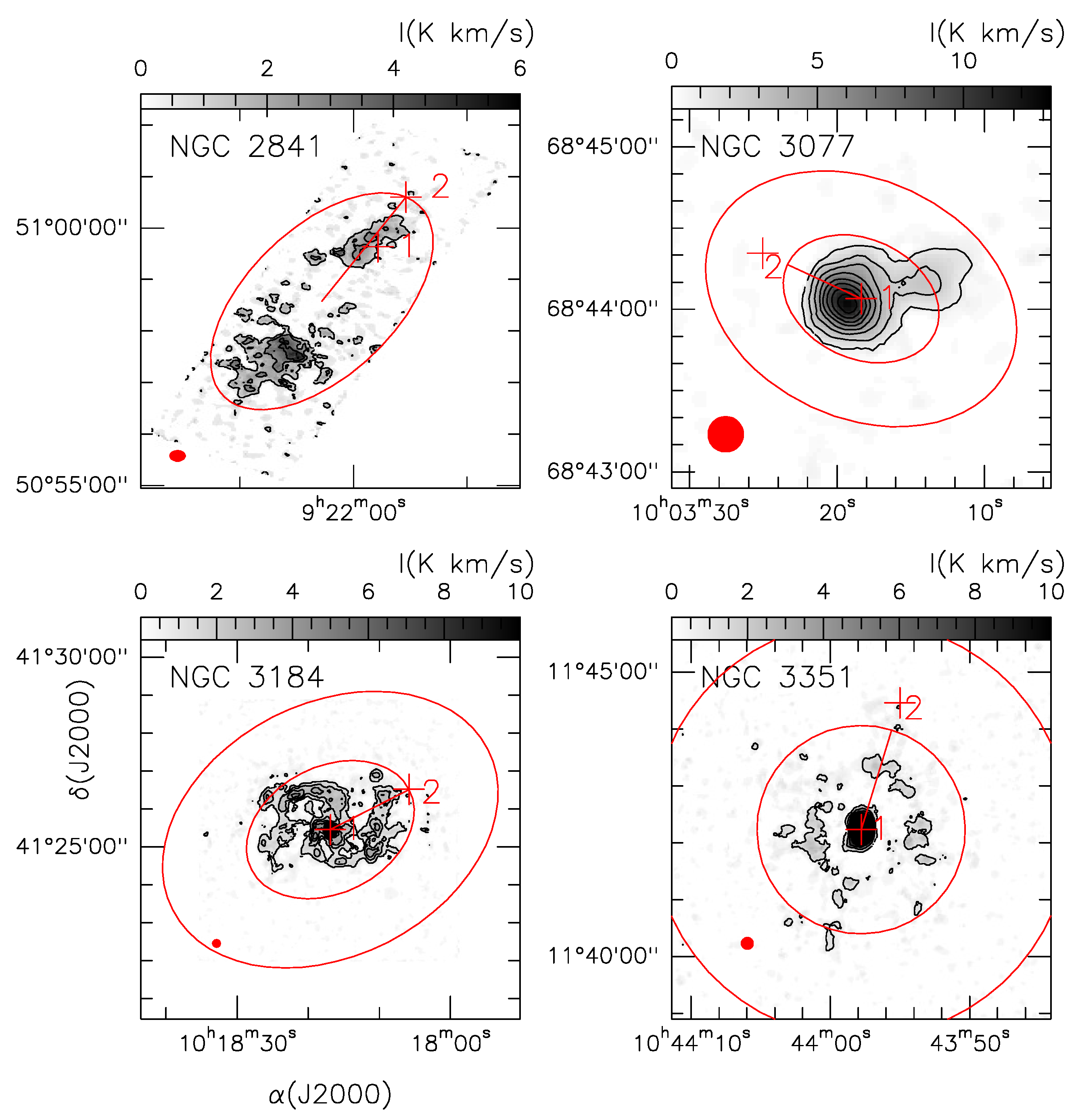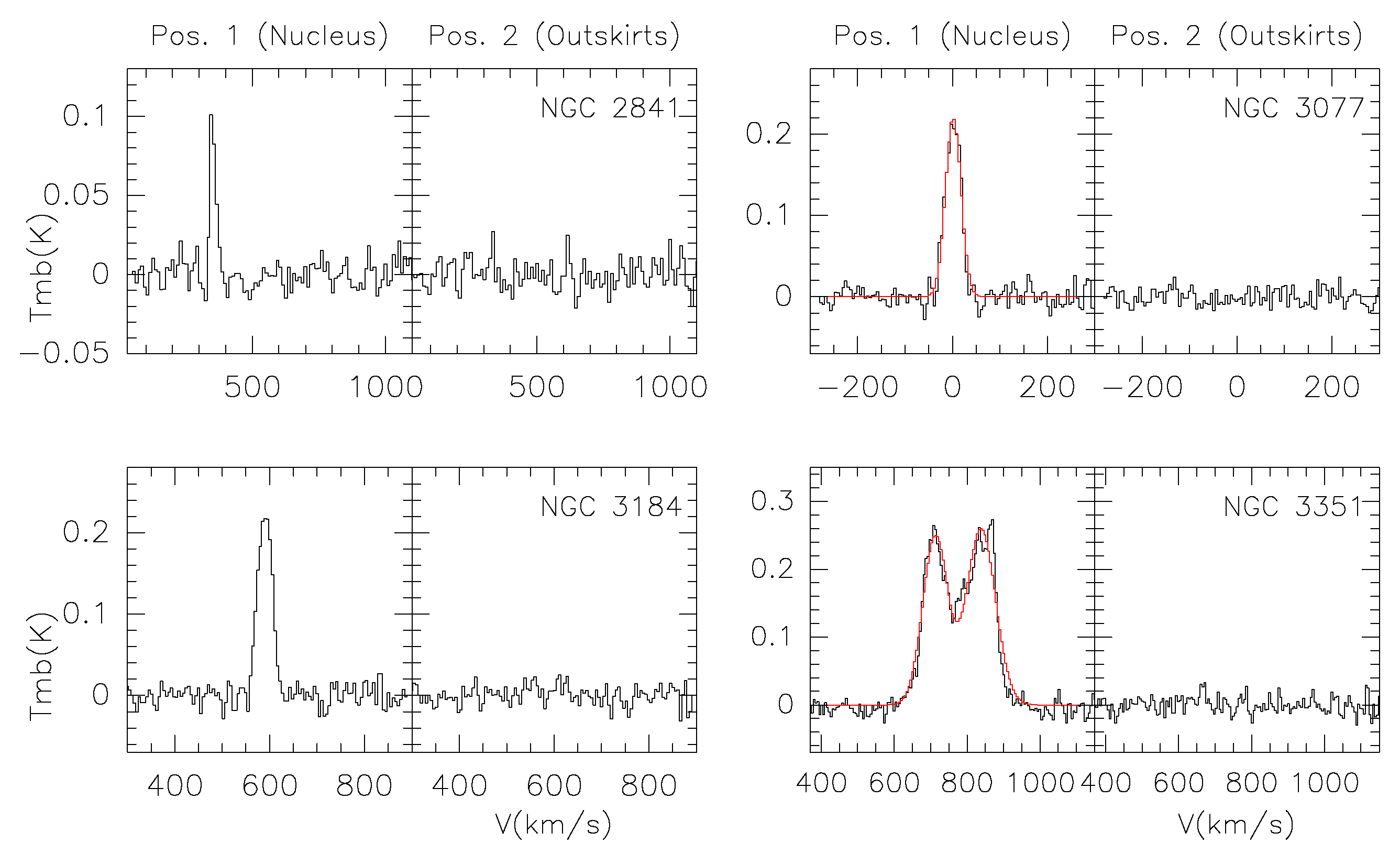Upper Limits to Magnetic Fields in the Outskirts of Galaxies
Abstract
:1. Introduction
Magnetic Field Constraint
2. Carbon Monoxide Data
3. Data Treatment
3.1. Spectra Selection
3.2. Gaussian Fitting and CO Luminosities
4. Results
4.1. Galaxy Mass
4.2. H Density, CO Column Density, and Kinetic Temperature
4.3. Magnetic Fields in Galaxies and Their Outskirts
5. Conclusions
Author Contributions
Conflicts of Interest
References
- Dotson, J.L. Polarization of the Far-Infrared Emission from M17. Astrophys. J. 1996, 470, 566–576. [Google Scholar] [CrossRef]
- Neininger, N.; Guélin, M.; Ungerechts, H.; Lucas, R.; Wielebinski, R. Carbon monoxide emission as a precise tracer of molecular gas in the Andromeda galaxy. Nature 1998, 395, 871–873. [Google Scholar] [CrossRef]
- Leroy, A.K.; Walter, F.; Bigiel, F.; Usero, A.; Weiss, A.; Brinks, E.; de Blok, W.J.G.; Kennicutt, R.C.; Schuster, K.F.; Kramer, C.; et al. Heracles: The HERA CO Line Extragalactic Survey. Astrophys. J. 2009, 137, 4670–4696. [Google Scholar] [CrossRef]
- Beck, R.; Fletcher, A.; Shukurov, A.; Snodin, A.; Sokoloff, D.D.; Ehle, M.; Moss, D.; Shoutenkov, V. Magnetic fields in barred galaxies. IV. NGC 1097 and NGC 1365. Astron. Astrophys. 2005, 444, 739–765. [Google Scholar] [CrossRef]
- Chyzy, K.; Buta, R. Discovery of a Strong Spiral Magnetic Field Crossing the Inner Pseudoring of NGC 4736. Astrophys. J. Lett. 2008, 677, L17. [Google Scholar] [CrossRef]
- Fletcher, A.; Beck, R.; Shukurov, A.; Berkhuijsen, E.M.; Horellou, C. Magnetic fields and spiral arms in the galaxy M51. Mon. Not. R. Astron. Soc. 2011, 412, 2396–2416. [Google Scholar] [CrossRef]
- Knapik, J.; Soida, M.; Dettmar, R.; Beck, R.; Urbanik, M. Detection of spiral magnetic fields in two flocculent galaxies. Astron. Astrophys. 2000, 362, 910–920. [Google Scholar]
- Sofue, Y. The most completely sampled rotation curves for galaxies. Astrophys. J. 1996, 458, 120–131. [Google Scholar] [CrossRef]
- Van der Tak, F.F.S.; Black, J.H.; Schöier, F.L.; Jansen, D.J.; van Dishoeck, E.F. A computer program for fast non-LTE analysis of interstellar line spectra. With diagnostic plots to interpret observed line intensity ratios. Astron. Astrophys. 2007, 468, 627–635. [Google Scholar] [CrossRef]
| 1 |


| Galaxy Name | RA 1 (hh:mm:ss.s) | DEC 1 (hh:mm:ss.s) | Morphology 1 | Distance 1 (Mpc) |
|---|---|---|---|---|
| NGC 2841 | 09:22:02.7 | +50:58:35.3 | SAa C | 14.6 |
| NGC 3077 | 10:03:19.1 | +68:44:02.2 | S0 C | 3.8 |
| NGC 3184 | 10:18:17.0 | +41:25:27.8 | SAc C | 11.3 |
| NGC 3351 | 10:43:57.7 | +11:42:13.0 | SBb C | 10.5 |
| Galaxy Name | Region | () | () | I | |
|---|---|---|---|---|---|
| km s | km s | K | km s | ||
| NGC 2841 | Position displaced 79 arcsec | 25.2 (2.0) | 352.0 | 0.1 | 23.4 |
| from nucleus | |||||
| outskirts | … | … | ≲0.03 | … | |
| NGC 3077 | nucleus | 38.2 (1.1) | 1.8 (0.5) | 0.2 | 40.2 |
| outskirts | … | … | ≲0.02 | … | |
| NGC 3184 | nucleus | 35.4 (1.0) | 590.3 (0.5) | 0.2 | 25.6 |
| outskirts | … | … | ≲0.03 | … | |
| NGC 3351 | nucleus | 80.9 (2.3) | 713.1 (0.9) | 0.3 | 45.9 |
| outskirts | … | … | ≲0.03 | … |
| Galaxy Name | Region | r | () | B | ||
|---|---|---|---|---|---|---|
| ×10 K km s pc | kpc | ×10 M | ×10 M | G | ||
| NGC 2841 | disk | 2.0 | 8.5 | 103.0 | 89.6 | ≲31 |
| outskirts | … | … | … | … | … | |
| NGC 3077 | disk | 2.3 | 0.4 | 1.3 | 0.4 | ≲6 |
| outskirts | ≲0.7 | 0.8 | ≲0.4 | ≲0.1 | ≲7 | |
| NGC 3184 | disk | 188.0 | 6.6 | 103.0 | 36.8 | ≲14 |
| outskirts | ≲81.1 | 13.2 | ≲44.6 | ≲15.9 | ≲19 | |
| NGC 3351 | disk | 226.0 | 7.1 | 124.0 | 32.1 | ≲11 |
| outskirts | ≲109.0 | 14.2 | ≲59.8 | ≲15.5 | ≲15 |
| Component | |||
|---|---|---|---|
| outskirts | ≲ cm | ≲35–38 K | ≲– cm |
| nucleus | 35–38 K | ∼– cm |
© 2017 by the authors. Licensee MDPI, Basel, Switzerland. This article is an open access article distributed under the terms and conditions of the Creative Commons Attribution (CC BY) license (http://creativecommons.org/licenses/by/4.0/).
Share and Cite
López, E.; Armijos-Abendaño, J.; Llerena, M.; Aldás, F. Upper Limits to Magnetic Fields in the Outskirts of Galaxies. Galaxies 2017, 5, 55. https://doi.org/10.3390/galaxies5030055
López E, Armijos-Abendaño J, Llerena M, Aldás F. Upper Limits to Magnetic Fields in the Outskirts of Galaxies. Galaxies. 2017; 5(3):55. https://doi.org/10.3390/galaxies5030055
Chicago/Turabian StyleLópez, Ericson, Jairo Armijos-Abendaño, Mario Llerena, and Franklin Aldás. 2017. "Upper Limits to Magnetic Fields in the Outskirts of Galaxies" Galaxies 5, no. 3: 55. https://doi.org/10.3390/galaxies5030055






